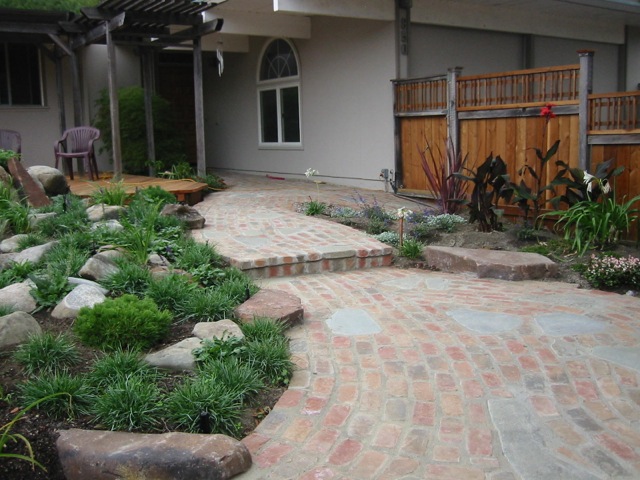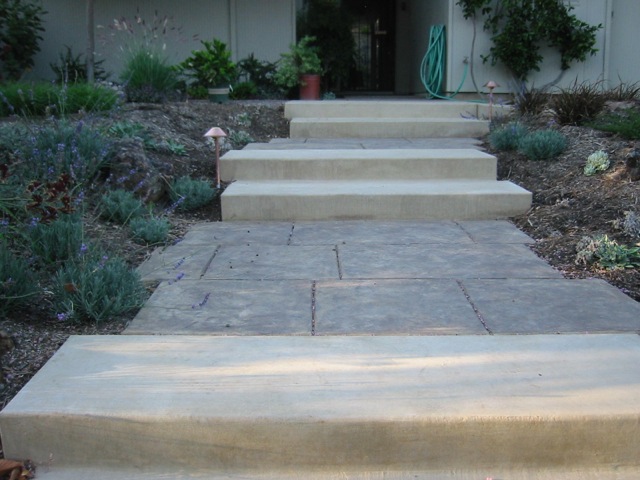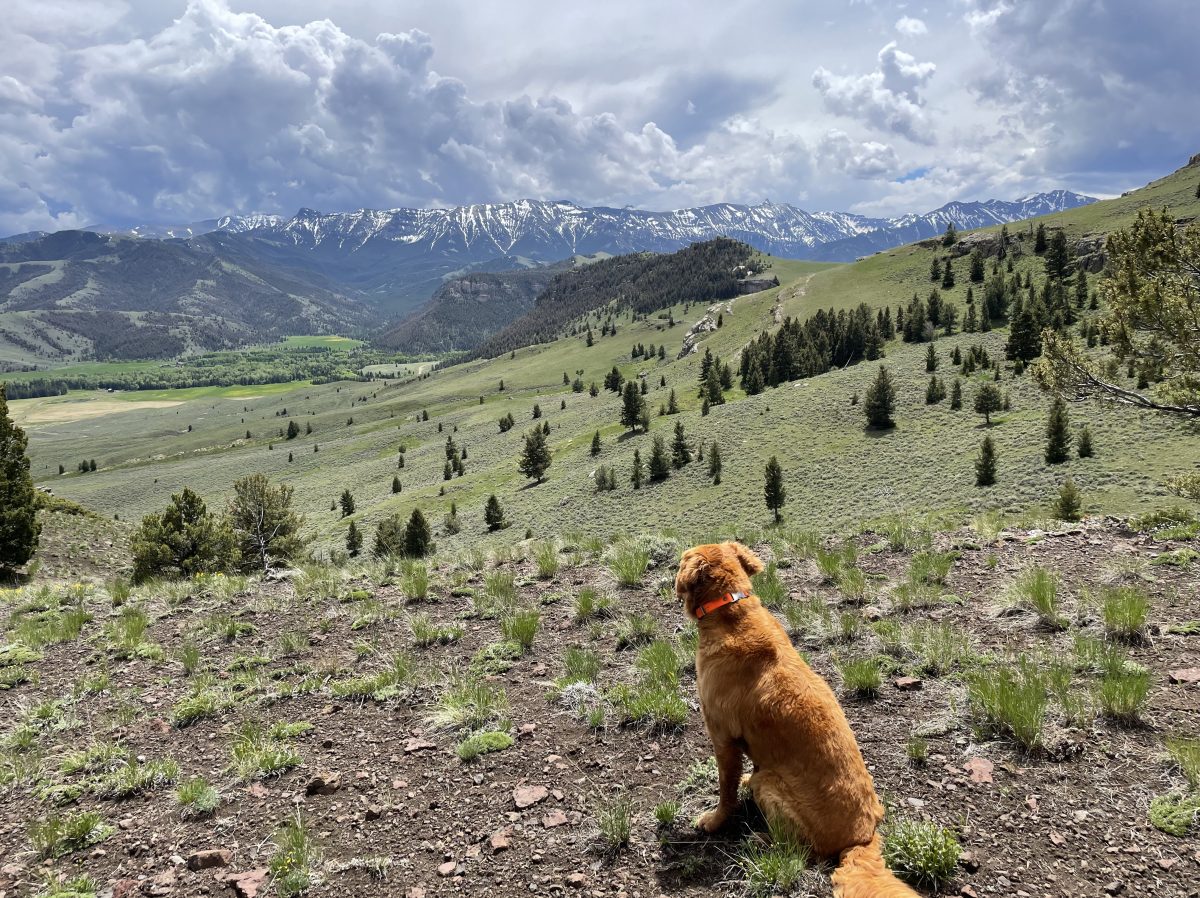I received a question from someone on using concrete pads underneath a DG patio, instead of prepping the subsurface with baserock material. That got me thinking about doing a post on patios in general and what, from a designer and installers perspective I know and understand.
First a few words in general regarding different types of patios. There are lots of different materials out there, some nice, some not, that can be used, and of course, different areas of the country will have different requirements. As far as drier climates goes, here are the basics:
1. Use materials like DG (decomposed granite) or concrete pavers (set in sand) when you need a permeable surface. Many counties are now requiring with new installations a minimum of permeable surfaces to prevent massive run-off problems. DG is useful as a patio some distance from the house in order to wipe off small bits of granite attached to shoes. Concrete pavers are set on a sand base and come in all types, from ugly to handsome.

2. For leisure patios with furniture lots of do-it-yourselfers or people on tight budgets like to put pavers and DG together. This works fine but keep in mind that high heels and furniture will get caught in the cracks of DG. There are ways to minimize this. Refer to my DG Patio book for spacing on pavers and proper installation. You will have to convince your contractor to use my methods because it is more time intensive, but it works.

3. For a long lasting patio that will have furniture on it, I prefer to pour a concrete base and put mortared pavers on. Another alternative is concrete. There have been lots of advances in concrete in the past few years. Meaning there are lots of types of decorative concrete looks, with stains and stamps and 2 or 3 dust on colors; finishes with broom, or salt pitting, or hard trowel. Just keep in mind that concrete is not a controllable substance and colors vary, fade, and cracks will develop no matter what.



A WORD ABOUT PAVERS: If you decide to go for real stone pavers, I salute you. Although concrete is cheaper, stone is beautiful and will give you lasting pleasure. So how do you choose amongst all the choices at the yard. First, go to a large landscape supply yard and pick out the stones you like. Get samples and bring them home and live with the samples for a week or more.

You must map out your design exactly. Usually the stone yard will have some basic design patterns for you to work with, or simply obtain some grid paper and go to work. Indian pavers have flooded the market in recent times. There are some incredibly beautiful stone and colors amongst the choices, but the stones are not all exactly to size. You’ll have to work with this when you or your contractor lays it down, which means some of the spacing will be off.

Next you must decide on the size of your joints. Be exact in your communications to your contractor. If you have uniform stone, you can lay them down with no mortar in between. If you want joints, or if your stone isn’t perfect as in the Indian pavers pictured below, you must have mortar showing in the joints.

As far as flagstones go, there are many types, some of which I do NOT recommend because you will develop moss in the wet season and you MUST seal these types every year to prevent mold. I discuss this more in depth in my eBook.
In general choose flagstones that are hard with small pores. These would be stones that come from places like Montana. Flagstones come in many names, and what’s called one name in one yard will be named something else in another, even if its the same material. Just make sure the flagstone is dense.
Another thing you want to watch for in flagstone is how slick it is. Slate, though gorgeous, is really slippery when wet. I’ve heard that a little bit of sand in your sealer can help this problem. Better to avoid it from the start.
For a more in-depth discussion on these topics, see my DG patio book. In it I discuss all the pros and cons of different materials, as well as give exact instructions for the installation of the different mediums, whether your contractor installs it or you do.
I’ve tried to keep the price to a bare minimum and it includes all the tips I’ve learned from years of experience. Good luck and do it right from the beginning. Hardscape, unlike plant material, cannot be picked up and moved, and is expensive!
Also Read:-

I just installed DG base of about 4″ – 6″ thick for a pathway and patio. I plan to add about 2″ of stabilized DG, but have yet to do so. I used a vibrating plate to tamp down the DG base twice, once when half of it was in place, then again when the rest was laid down. It felt pretty solid once tamped. Yesterday it rained about 1″. Today the DG feels a bit soft and spongy. Should I tamp it again, or will it harden once it has dried?
Also, would a Jumping Jack (sounds like a jack hammer with a foot plate instead of a spike) be better to use than a vibrating plate to increase the compaction?
LikeLike
Your site is beautiful! Pls advise. I just replaced my front yard in Van Nuys with flagstone (yes, I used Arizona) over a 2-3″ base of sand. Random thyme planting is going in BUT, for the most ~ should I broom in DG w or w/o stabilizer??
LikeLike
Thank you so much. I am very lucky to have found your website! Cheers, Nate
LikeLike
Can you explain what base rock or road base is?
Thanks for all the great tips. You helped me avaoid a near disaster.
LikeLike
Thanks again. I saw that American Soil and Stone have both recycled base rock and virgin base rock both of which they note meets CalTrans standards for road base. The recycled is made from recycled concrete and asphalt. The virgin is rock crushed just to make base rock.
LikeLike
Hi Leslie. It’s the middle of the nite here, and I cannot sleep thinking about this project for my backyard. Luckily, I found your site here and I do plan to purchase your ebook later on after I post this and go back to sleep for a few hours! If you can see my Gravatar, that is what I am planning. The yard is about 900 sq feet. We have cut and removed all sod. Along the perimeter, we want to lay crushed decorative stone with a coupe of planting beds. Inside the crushed stone we would like to lay DG. Just inside the perimeter of crushed stone, we want to have an RadioControlled car course. Inside that RC Course, we want to lay a 3 hole mini putting course of two grades of Astro-Turf. I pride myself on doing most things myself, but I’ve never taken on something like this. Your site answers a lot of my questions of How to do this, but, I can’t for the life of me, determine if it is even probable to set these many borders for the RC course, and the AstroTurf. So… if you can see my Gravatar, do you think this is probable? Have you done anything like this? If it is probable, when in the process should I place these winding borders? After the Weed control barrier? After the Gravel? I am stuck and need help! If you cannot see the Gravatar’s details, how can I contact you? thx! Ron
LikeLike
Does not seem like a hardthing to do. The DG is laid down on a different surface than the astroturf. I’ve only done astro turf once and the homeowner took care of it but you will have to prep that differently. Other than that you should get the book. I never use Weed Barrier for DG as with a good prepped surface it is useless because weeds will not come in from below but if you do get any they will blow in from outside. You’ll have to put your borders down after you excavate to separate out the different areas and then compact as required. You also should use a very flexible border if you want it so curvey. See if trek is good enough. If not, then you’ll have to use layers of wood benderboard tied together with wire. Don’t use the plastic as its too cheap. They may be some other possibilities out on the market that you can get creative with.
LikeLike
THIS IS NOT INSTALLED IMPROPERLY, IT JUST WAS NOT INSTALLED TO YOUR LIKING
LikeLike
Hi Joe, thanks for your comment. I am assuming you are referring to the patio photo above which shows a flagstone patio in progress,which is labeled:
“This Decomposed Granite with flagstone patio is not done correctly. Spaces are too big and will catch high heels and chairs”
In essence you are correct. If you must know, this is a photo of the very first ‘flagstone with DG’ patio I ever installed, many years ago. I had just begun working with this landscaper, a very reputable contractor who I went on to install many of the jobs you see in my other photos. We got to this point in the job, almost finished, when the homeowner along with myself, realized the problem she would have with her patio chairs and table. Thus we pulled all the flagstone and reset it to the 3/8″ spacing that I now recommend. I did the changes for the homeowner all at my expense. Good learning experience for me!
So, yes, the patio was definitely ‘installed properly’ and would work fine, as long as someone with high heels didn’t walk on it (especially in wintertime in Northern CA where this job was done. There could be a big liability for the homeowner, not to mention an injured person’s sprained ankle or worse). And, as I’ve said, patio furniture that has thinner legs would sit lopsided.
Hopes that clarifies for you.
LikeLike